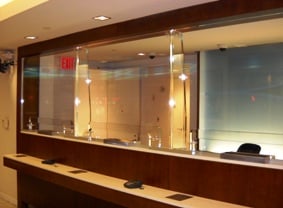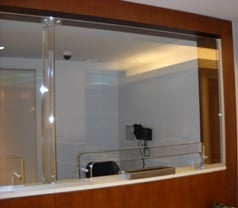Total Security Solutions vice president Jim Richards travels extensively, and everywhere he goes he sees terrible bulletproof glass installations. These range from awkward angles and ugly finishes to downright dangerous lapses in design. “I see all kinds of stuff all the time,” he sighs, but most bad bulletproof glass installations commit one (or more) fundamental sins: “Bad material, bad installation, or bad design.”
BAD BULLETPROOF GLASS
It’s only in the last decade or so that bulletproof glass has become a regular part of doing business in America. This means that the vast majority of installations (even shoddy ones) at least use modern materials–perhaps not the current top-of-the-line in advanced bullet-resistant barrier technology, but certainly acceptable thicknesses of quality steel, acrylic, or polycarbonate. The exceptions are a few major urban areas that were early adopters of bulletproof glass, such as Detroit. By the late 1970s almost every existing Detroit location that might want bulletproof glass had acrylic installed. At that time smaller ammunition and low-quality street firearms were the norm, and posed less of a threat. Today, Jim often finds it almost unbearable to walk around Detroit, where almost all of the older “bulletproof glass” he sees is low-quality acrylic just an inch thick (if even)–dangerously obsolete transparency with essentially no bullet-stopping capability.
GOOD GLASS, BAD INSTALLATION
It’s even more frustrating to see a decently designed system fabricated from quality components, then poorly installed by a clueless contractor. Often this is simply aesthetic: crooked window frames, rough-cut edges, exposed hardware, or misaligned sheets of bulletproof glass. 
 But it can be worse: “I’ve gone into banks and seen the system installed entirely backwards”–that is, the baffles were placed on the customer side, instead of the interior. In this configuration, a would-be robber could easily angle a pistol’s barrel through the gap and wreak havoc in the “secure area.”
But it can be worse: “I’ve gone into banks and seen the system installed entirely backwards”–that is, the baffles were placed on the customer side, instead of the interior. In this configuration, a would-be robber could easily angle a pistol’s barrel through the gap and wreak havoc in the “secure area.”
BAD BULLETPROOF DESIGN
Provided the underlying design is solid, both installation and material problems can be remedied relatively easily (although it will likely be a costly job). But too few bulletproof companies take the time to fully understand the workflow and practical day-to-day demands of the locales they are being paid to secure. According to Jim, “All these things need to be taken into consideration: What kind of merchandise do you want on the counter? How are you going to operate? How are you going to perform your daily functions?” If some aspect of a design gets in the workers’ way, they’ll defeat the bulletproof security themselves and save bandits the trouble.
As Jim explains: “It goes back to the adage that you have to keep in mind how the business functions. For example, I was at a store in Warren, Michigan, and they’d mounted the bulletproof glass so that the counter was basically just a five or six-inch glove ledge; there was no room to put anything on that counter. It drove customers and cashiers nuts. I’ve been in places like this before where the workers decide to take the operable window completely out so that they’d have some counter space.”
Even worse are designs that fail to take into account the ventilation and air-flow demands of the heating and cooling system. “I’ve been in national chains where they have the door to the bulletproof enclosure propped open during the day because they don’t like digging out their keys all day, or because it’s hot in there. Instead of the company getting the ductwork regulated properly, the workers prop the door open to get some airflow. An armed robber can sprint up on an unsuspecting cashier faster than he can slam and lock that door.”
